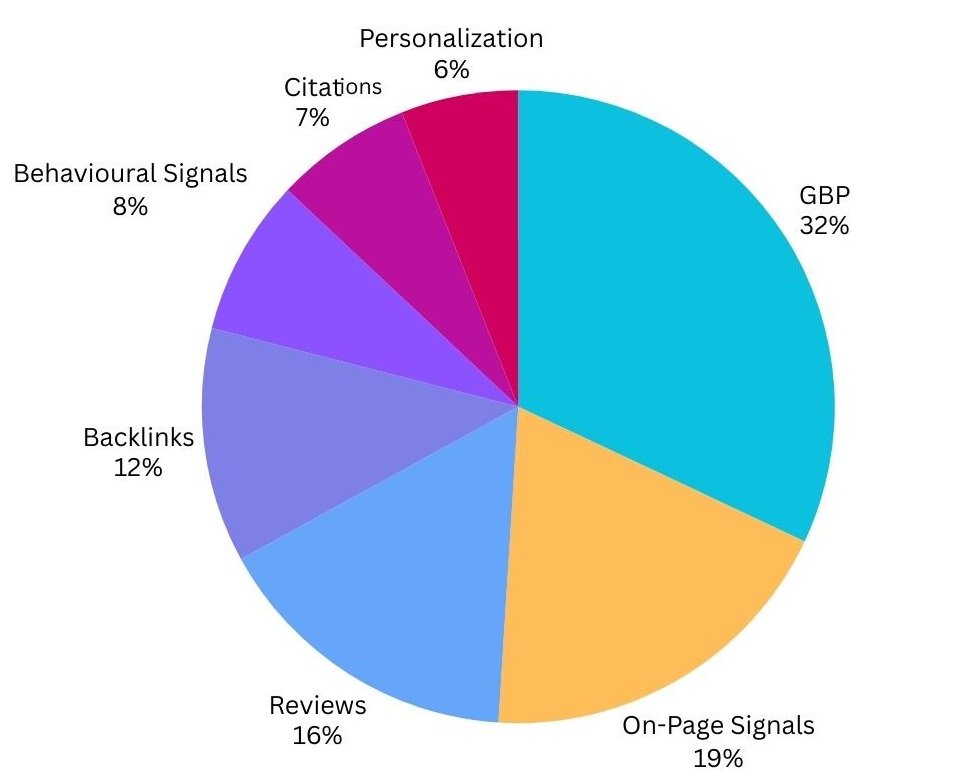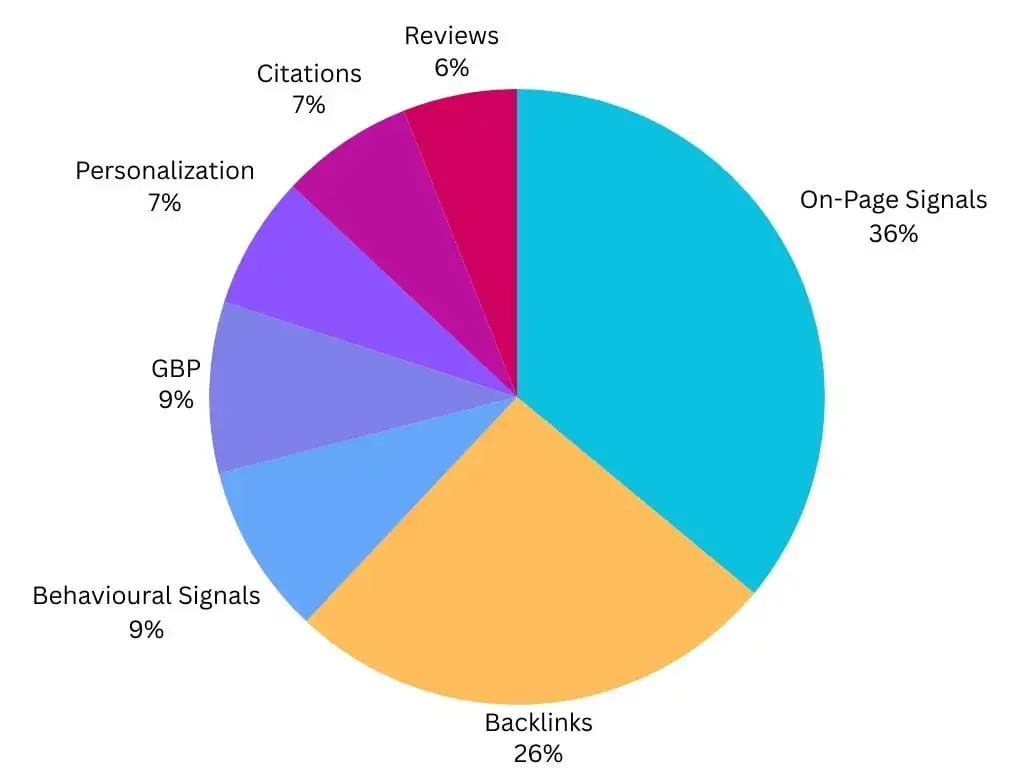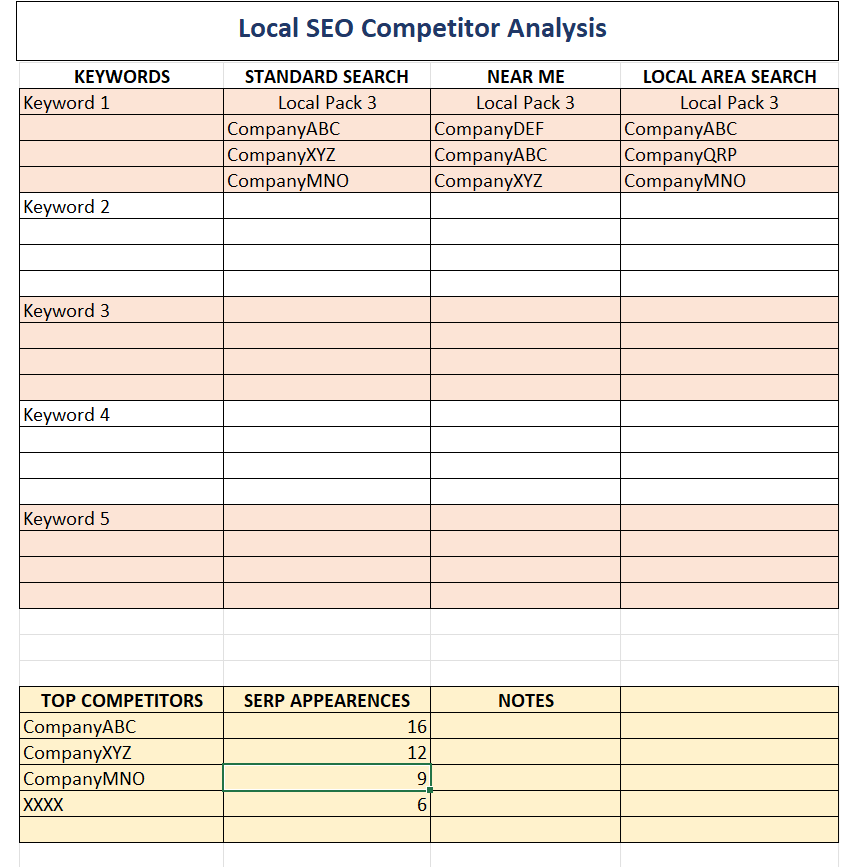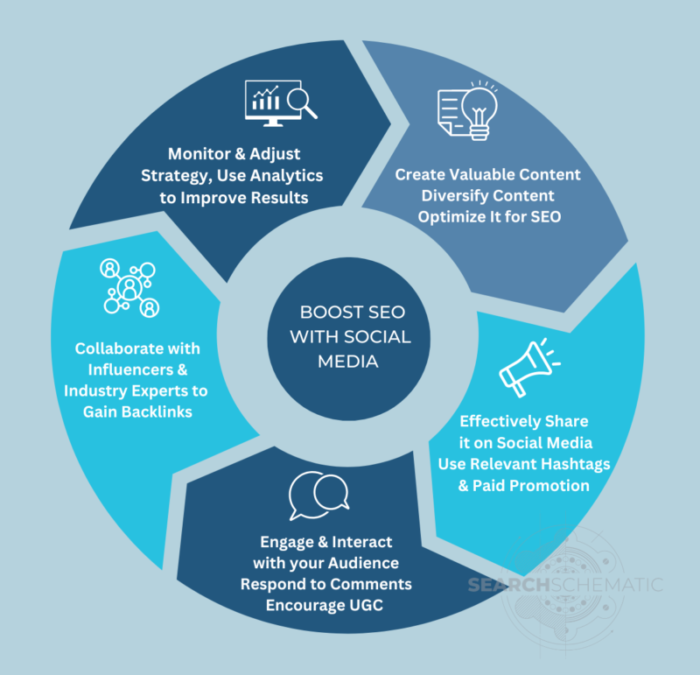



Chapter 1: Understanding the Fundamentals of Local SEO
This chapter provides an introduction to Local SEO, highlighting its importance for businesses focusing on local customers. It distinguishes between local and traditional SEO, examines how businesses appear in local searches and identifies businesses that benefit most from local SEO. The chapter also covers the basics of Google Business Profile, which is essential for effective local SEO, setting the stage for enhancing your business’s local online visibility.
1.1. What is Local SEO?
Local SEO is the optimization of a business’s online presence to enhance its visibility for location-specific search queries on search engines. For example, a dentist in Denver would utilize Local SEO strategies to ensure their practice appears prominently when users search for ‘dentist in Denver’ or ‘dental clinic near me.’ if they are within the vicinity.
1.2. Why Is Local SEO Important?
A robust, ongoing Local SEO strategy ensures internet users can effortlessly locate your business online, including on platforms like Google Maps. This visibility empowers potential customers with vital information, influencing their decisions when considering purchasing your products or engaging your services—be it online or in-store.
Here are Some Stats:
- 46% of all Google searches aim at local data. (Source: GoGulf)
- After conducting a local online search, 72% of users ended up visiting a shop located within a five-mile radius. (Source: HubSpot Marketing Statistics)
- A staggering 97% of people learn about local businesses, mainly via online platforms. (Source: SEO Tribunal)
1.3. What Businesses Qualify For Local SEO
Any business with a physical location or offering services in specific areas benefits from Local SEO. While having a physical address isn’t an absolute necessity for Local SEO optimization, it greatly enhances the effectiveness of such efforts. The Google Business Profile, a pivotal tool for Local SEO, requires a street address for verification. However, it does offer businesses without a storefront the flexibility to hide this address from public view. We will cover more about Google Business Profile in this guide.
1.4. Difference Between Traditional SEO and Local SEO
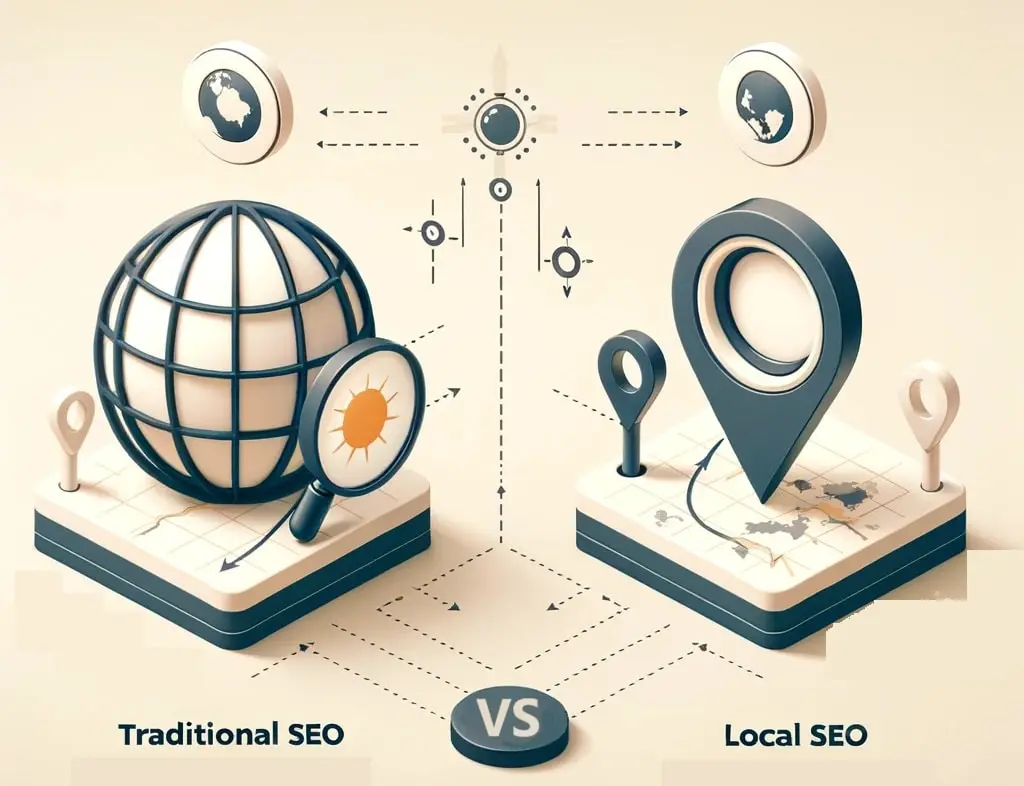
Traditional Search Engine Optimization (SEO) aims to improve a website’s organic search rankings to attract relevant traffic. Conversely, Local SEO specifically targets localized organic search results, such as the Google 3 Pack, Local Finder, and Google Maps. It’s essential to recognize that Local SEO is a subset of traditional SEO.
Did you know?
A good traditional SEO strategy is needed for local SEO to work best. SEO factors like backlinks, quality content, technical SEO, and webpage loading speed influence your Local SEO.
1.5. How Localized Searches Appear on Search Engines
Searches conducted to locate products and services within a specific geographic region are termed local searches. Distinct from organic search results, local searches appear in various ways, including local organic, the Google Local Pack, Local Finder, Google Maps, and Google Business Profile listing.
Google Local Pack
Typically, the three featured listings you see in the search results (SERPs) for your query.
Google Local Finder
This feature surfaces after clicking on ‘more places’ at the end of the Google Local Pack.

Google Map Listings
It displays when you input your query directly into Google Maps or select maps after typing it into Google Search.

Google Business Profile Listing
It’s vital to understand that to feature in the listings mentioned above, you must have a Google Business Profile (formerly “Google My Business”). Google pulls your business details from this profile. Your Google Business Profile listing typically emerges when a user types your brand name into the search box.
1.6. Understanding Google Business Profile
A Google Business Profile is crucial for local SEO success. Let’s explore it to grasp its fundamentals.
Per Google, the Google Business Profile is a user-friendly platform that allows businesses and organizations to manage their online visibility on Google. Verifying and updating your business details increases the likelihood of potential customers discovering your services.
1.6.1. Understanding Your Business Eligibility & Type
Google outlines specific criteria for businesses to be eligible for a Google Business Profile:
- Physical Businesses: These are establishments with a fixed location where customers can visit, such as stores, restaurants, or other venues.
- Service-Area Businesses: These businesses serve customers within a certain geographic area but do not have a customer-facing storefront—for example, a plumber who serves multiple neighborhoods from a home base. Per Google’s guidelines, these businesses should specify their service areas in their Google Business Profile and have the option to hide their address from public display. (Note: Google doesn’t want you to display your address if you don’t serve customers in person at that address.)
- Hybrid Businesses: These enterprises operate with a physical storefront and provide services in a designated area. For instance, a restaurant that also delivers or offers catering services to nearby regions can list both its physical address and service area.
It’s important to note that, according to Google, purely online businesses without in-person contact with customers are generally not eligible for a Google Business Profile. Business owners should consult the latest Google guidelines for the most up-to-date information, as policies can change.
1.6.2. Reviewing & Complying With Google Guidelines
With a staggering 90% of internet users utilizing Google, it’s clear why it’s the leading search engine. Google has set strict guidelines for how businesses should represent themselves on its platform. Reviewing these guidelines is crucial because they clearly explain the important policies. Not following them can result in the suspension of your Google Business Profile.
Key Insights from Google’s Business Profile Guidelines:
- Authentic Representation: Your business’s online presence should align with its real-world identity. For instance, if you run Antonio’s Pizza, known for its deep-dish delight, your listing should be ‘Antonio’s Pizza’ and not ‘Deep Dish Pizza’.
- Precision in Details: Ensure your address and service areas are accurately provided. It’s crucial to have only one profile for your business to avoid confusion on Google Maps and Search.
- Content Relevance: Choose categories that accurately reflect your business’s primary services or products.
- Avoid Prohibited Content: Ensure your profile doesn’t contain content prohibited by Google, such as misinformation, inappropriate or offensive content, or private/confidential data. Always be informed about what is and isn’t allowed.
Chapter 2: How Local Search Works
Chapter 2: “How Local Search Works” lays out the fundamental principles that underpin Google’s local ranking system. Armed with this knowledge, readers can make informed decisions to strengthen their local SEO strategies and improve their online visibility.
2.1. Understanding How Google Determines Local Rankings
Although Google is known for its guarded algorithms, it has provided some transparency on how it determines local rankings. In a public document titled “How to improve your local ranking on Google,” the tech giant identifies three primary principles in their latest algorithms: relevance, distance, and prominence.
Google guidelines are helpful, but take a brief overview without too many details. We will dive deeper into the three main components and reveal important, useful information not detailed in Google Guidelines.
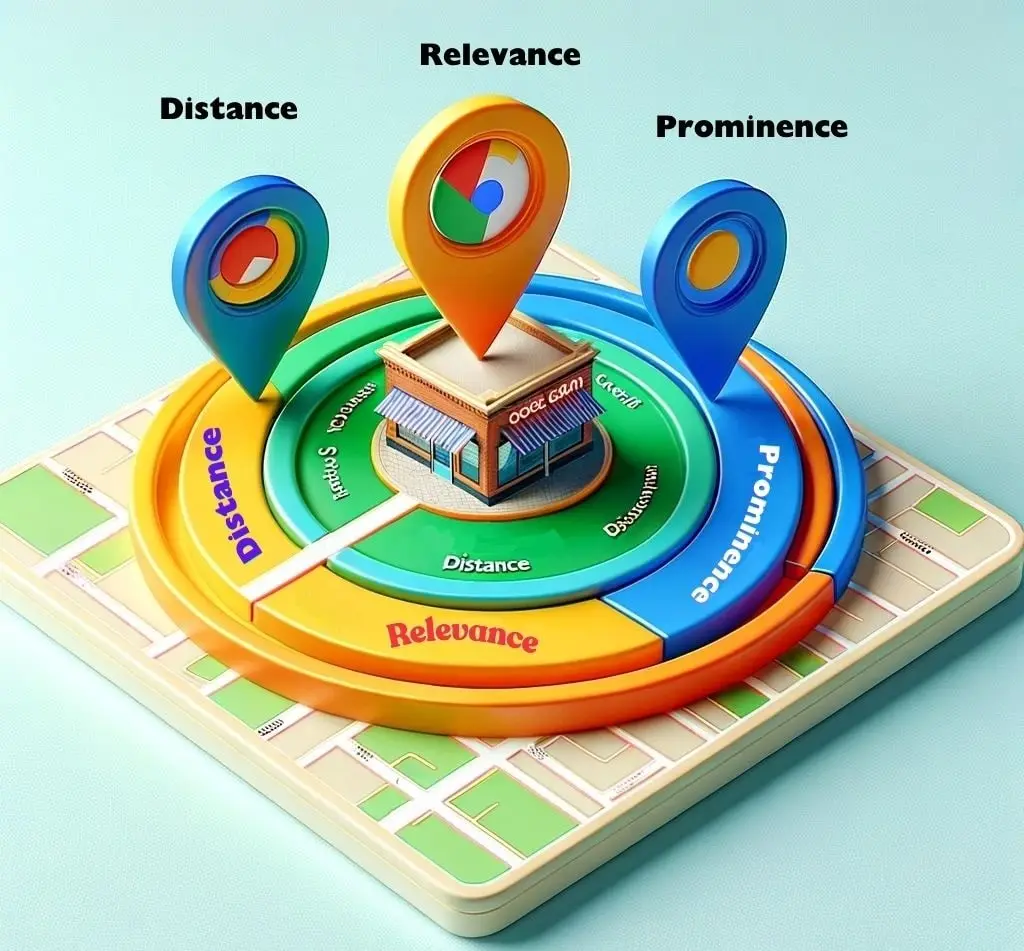
2.2. Relevance
Relevance pertains to how well a local Business Profile matches the searcher’s query. According to Google’s guidelines, by furnishing complete and detailed business information, businesses can enhance their relevance, assisting Google in matching their profile to the most fitting searches.
There are four factors that are not detailed in Google guidelines that significantly impact your local rankings and prove relevance.
2.2.1 Business Title
As previously mentioned, Google penalizes businesses that use keyword-rich titles in their Google Business Profiles that don’t match their actual business names. In addition to this, the business title itself plays a significant role in determining relevance. For example, if you are a handyman and name your shop “Antonio Handyman,” it’s likely to be more relevant in search results than if it were simply named “Antonio.” Therefore, when naming your business, it’s essential to factor in online discoverability and SEO principles.
2.2.2 Google Business Profile Categories
Selecting primary and secondary categories for your business profile on Google might appear simple. However, these choices necessitate careful research, given their significant influence on the search terms for which your business ranks.
To underscore the importance of category selection, let’s consider a case study from our agency, Search Schematic:
One of our clients primarily dealt with masonry work but also provided other construction services. On their Google Business Profile, they had chosen “general contractors” as their primary category. This resulted in their low visibility in local search results. A mere change in their primary category to “masonry contractor” led to a noticeable improvement in their rankings for relevant search terms in just a few days. It’s worth noting that this client already had an effective On-Page SEO and Technical SEO strategy, positive reviews, and robust backlinks in place.
How to Choose Google Business Profile Categories
If you’re uncertain about the most fitting categories for your business, consider these two strategies:
- Do keyword research to find the most searched terms related to your business. This can help you choose your primary and secondary categories.
- Observe the categories chosen by your top-ranking competitors. Their selections can offer insights for your own business profile.
We will cover this in more detail in Chapter 4 on Competitor Analysis.
2.2.3 Website URL
Google’s local search ranking algorithm goes beyond just examining your Google Business Profile. It scours information about your business across the web to determine relevance for search queries. Your website stands as a primary reference point for Google. Hence, linking a website URL in your Google Business Profile containing content that aligns with your primary and secondary categories is crucial. Typically, your website’s homepage is suitable for this, as it often provides a comprehensive overview of your business offerings.
It is important to note that traditional On-Page SEO optimization enhances and aids your relevance for Local SEO.
2.2.4 The Impact of Customer Reviews on Local Rankings and Relevance
Google’s documents state that reviews are part of their local ranking factors. However, it’s worth noting that reviews also play a significant role in relevance. For instance, if you run a bakery that also sells vegan products and a customer leaves a review mentioning the ‘best vegan cake,’ Google will consider this term when matching search queries.
Further in this guide, we will delve deeper into the importance of reviews, including strategies for tailoring your review requests based on the specific products or services a customer has purchased.
2.2.5 Completing Your Google Business Profile
While understanding the key factors we’ve discussed is essential, it’s equally crucial to thoroughly complete your Google Business Profile in line with Google’s guidelines. This includes accurately providing details such as opening and closing times, menus (if applicable to your business, such as in a restaurant), and filling out any other relevant sections. Each piece of accurate information you add not only enhances the integrity of your profile but also indirectly boosts its relevance in search results. ( See Section: 3.1.)
2.3. Distance (Proximity)

Distance, often referred to as “proximity,” is a prominent ranking component explicitly stated in Google’s guidelines. Essentially, this factor measures how far a business is from the location specified in a user’s search query. If a searcher doesn’t pinpoint a location, Google relies on its knowledge of the user’s current position to determine the distance.
This user-centric ranking criterion was emphasized even more with Google’s “Vicinity” update rolled out in December 2021, and this update is still actively in place. Businesses have minimal influence over this factor – unless they decide to relocate. It’s noteworthy that, with the appropriate permissions, Google collects location data from mobile devices. This means your business’s ranking can vary depending on the exact location of the searcher.
Did you know?
In the early days of Google Maps, search results were more static and often favored larger brands. However, thanks to Google’s continuous algorithm updates, today’s local search landscape levels the playing field, allowing both small and large businesses to be prominently featured in the Local 3-Pack.
2.4. Prominence
Prominence refers to the recognition and popularity of your business both online and offline. Google assesses a variety of signals to determine the prominence of your listing. While well-known entities like landmark museums, iconic hotels, or popular brand stores may naturally hold an advantage due to their established prominence, smaller or less-known businesses are not without recourse. There are strategic measures these businesses can take to bolster the signals that Google considers for ranking purposes.
Did you know?
While Google uses a variety of signals to assess prominence, location data from mobile devices can give Google insight into foot traffic and popularity among local customers.
In the forthcoming chapter, “Local SEO Ranking Factors,” we will delve into each factor in detail and discuss how businesses can effectively optimize to enhance their prominence.
Chapter 3: Local SEO Ranking Factors
In this chapter, we will dissect the ranking factors foundational to local search core principles and demonstrate how to optimize them to improve your business’s or organization’s visibility in local search results.
2023 Google Local Pack/Finder Ranking Factors
The chart above represents the findings of a 2023 survey conducted by Whitespark, where dozens of local SEO experts weighed in on the ranking factors for Google’s Local Pack.
2023 Google Local Organic Ranking Factors
The chart above represents the findings of a 2023 survey conducted by Whitespark, where dozens of local SEO experts weighed in on the ranking factors for Google’s Organic Rankings.
Let’s dive into each ranking factor in detail, including a bonus ranking factor to give your business or organization a competitive edge.
3.1. Google Business Profile (GBP)
As underscored in previous sections, your Google Business Profile (GBP) is pivotal for Local SEO. It plays a significant role in influencing and supporting the key local search principles: Relevance, Proximity, and Prominence. A fully and accurately completed profile is essential for boosting your rankings. Consider these factors:
3.1.1 Business Name
Ensure your business name is accurate and relevant. (See section 2.2.1)
3.1.2 Selecting Categories
Choose the most appropriate primary category and secondary categories that best describe your business. (See section 2.2.2 & 4.2.)
3.1.3 Profile Completion
Populate your profile comprehensively, making sure all sections relevant to your business type are filled out to provide complete information about your business. This includes:
- The accurate NAP details: name, address, and phone number.
- Service Areas (if applicable)
- Services or Products your business offers.
- Your business website address/landing page. (See section 2.2.3)
- Opening and closing hours, including on public holidays, for instance if you are closed or operate on special hours.
- Photos of your business/organization.
- A business description that provides a glimpse into your offerings and company profile.
- Attributes. (Select relevant features that inform users about crucial aspects of your business, like accessibility, health and safety, amenities, and more.)
3.1.4 Google Reviews
Reviews play a crucial role in your local search rankings. We have dedicated a whole section to reviews. (See section 3.3)
3.1.5 Maintenance
Maintaining the accuracy and relevance of your Google Business Profile is essential in Local SEO, as it’s not a one-time task but an ongoing process. Ensure your opening hours are always up-to-date on your GBP and across all platforms, including your website. Respond to both negative and positive reviews. (See sections 3.4.1 and 3.4.3) Keep your profile fresh by sharing news or special offerings regularly. For instance, if you run a restaurant, you’ll want to update your menu on GBP whenever there are changes. Regular updates help in keeping your profile engaging and accurate for potential customers.
3.2. On-Page SEO Signals
On-page signals are a critical component in Local SEO, as highlighted in the ranking pie chart. They serve two main purposes: optimizing your site for search engines to achieve higher rankings and improving user experience. Let’s break these down into two parts:
- Local Search Signals aim to tailor your website for local audiences and improve local search rankings.
- On-page SEO, a key component of traditional SEO, optimizes your site’s content and HTML to enhance visibility in search results.
Both are crucial for boosting your local search presence, ensuring your website appeals to both general and local search queries. Let’s explore both:
3.2.1 Incorporating Local Search Signals

Website Mockup
Integrating local search signals into your website’s design and content ensures that your website appears in local search results and caters to your local audience. To achieve this, see the following checklist to ensure your website is finely tuned for local search signals:
3.2.1.1 N.A.P. Consistency
Maintain consistent Name, Address, and Phone number (N.A.P.) information across your entire web presence. Display this crucial data prominently on every site page, ideally within the header, footer, or sidebar, to ensure it’s easy to find. For businesses with multiple locations, create a dedicated contact page that lists all locations with their respective N.A.P. details.
3.2.1.2 Accessible Contact Information & Map Integration
Ensure your contact information is easily accessible by providing a direct link to your “Contact” or “Locations” page in the main navigation. This aids user experience and signals location relevance to search engines. Additionally, integrating Google Maps on these pages can significantly enhance user engagement, making it easier for customers to find your physical location. This integration not only improves convenience for users but also strengthens the local SEO of your website.
3.2.1.3 Title Tag Optimization
Integrate the city or region name into the title tags of your pages to enhance local search visibility. This should be done in a way that feels natural and relevant to the content on the page.
3.2.1.4 Content Localization
Localized content optimization involves tailoring your website’s content to include specific references and keywords that resonate with the local community you’re serving.
For instance, a coffee shop in Manhattan might highlight its “Midtown espresso blends” or offer a “Central Park picnic package.” These details not only improve your site’s relevance in local search results but also resonate with the daily life and interests of the community, reinforcing your position as a local staple.
Remember, localized content should feel natural and relevant, not just a list of locations or services. It’s a conversation with your neighborhood, an invitation to locals to engage with your brand on a personal level.
3.2.1.5 Location Pages for Multi-Location Businesses
For businesses with multiple locations, make each location easy to find with a dedicated page accessible directly through the main menu or the footer or via a user-friendly store locator widget.
3.2.1.6 Incorporating Reviews and Testimonials
Feature customer reviews and testimonials prominently on your site. These act as social proof and contribute to the site’s local relevance and trustworthiness.
3.2.1.7 Singular Web Presence
Ensure that you maintain only one website for your business to prevent any confusion for search engines and users and to consolidate your site’s authority.
Each of these components plays a vital role in signaling to search engines that your website is a credible, authoritative source for users searching for local businesses. Remember, a website that’s optimized for local search not only helps improve visibility but also enhances the user experience for potential customers.
3.2.2 On-Page SEO Optimization
On-page SEO is a critical component of local search rankings, acting as a direct line of communication with search engines. It tells these engines precisely what your website is about and why it should rank well in local search results. It aligns with key principles such as relevance—making sure your content closely matches local search queries; prominence—ensuring your site stands out through quality and authority; and distance—by highlighting your local presence.
Key aspects of on-page SEO include:
- Optimizing title tags and meta descriptions with targeted local keywords.
- Ensuring consistency of NAP (Name, Address, Phone number) information across your website.
- Strategically using internal links to establish site structure and distribute page authority.
- Enhancing mobile-friendliness to cater to the vast number of users on mobile devices.
- Improving page loading speeds for a better user experience and improved search rankings.
For a detailed exploration of on-page SEO and its benefits for your local search presence, we invite you to visit our dedicated comprehensive on-page SEO guide. It provides actionable insights into each of these elements and how they contribute to your site’s search performance.
3.3. Reviews
Reviews are a direct line to customer perception and are explicitly acknowledged by Google as a factor influencing business prominence.

3.3.1 Diverse Review Platforms
Beyond Google reviews, the algorithm also considers reviews from reputable platforms such as Yelp, Trustpilot, Facebook Reviews, Airbnb, G2, Clutch, and others. It’s important to identify which platforms are most aligned with your business and target audience.
3.3.2 Soliciting Reviews
Understand and respect the review policies of each platform. While Google permits the solicitation of Google reviews as long as their policies are strictly followed, Yelp prohibits it. Adherence to these policies is critical to avoid penalties or legal issues associated with fake reviews or incentivized feedback.
3.3.3 Relevance of Keywords in Reviews
The relevance principle in Google’s local search algorithm also examines the content of reviews to match search queries. When encouraging reviews, gently prompt your customers to include details about the specific services or products they experienced or to mention the location of your business. This strategy helps to underscore the relevance of your offerings and boost the usefulness of your reviews in search results.
3.4. Reputation Management (Bonus Ranking Factor)
Reputation management is a multifaceted process that significantly impacts local search rankings by influencing a business’s prominence. A sterling reputation, built and maintained through strategic engagement and responsiveness, can lead to higher rankings in local search results.
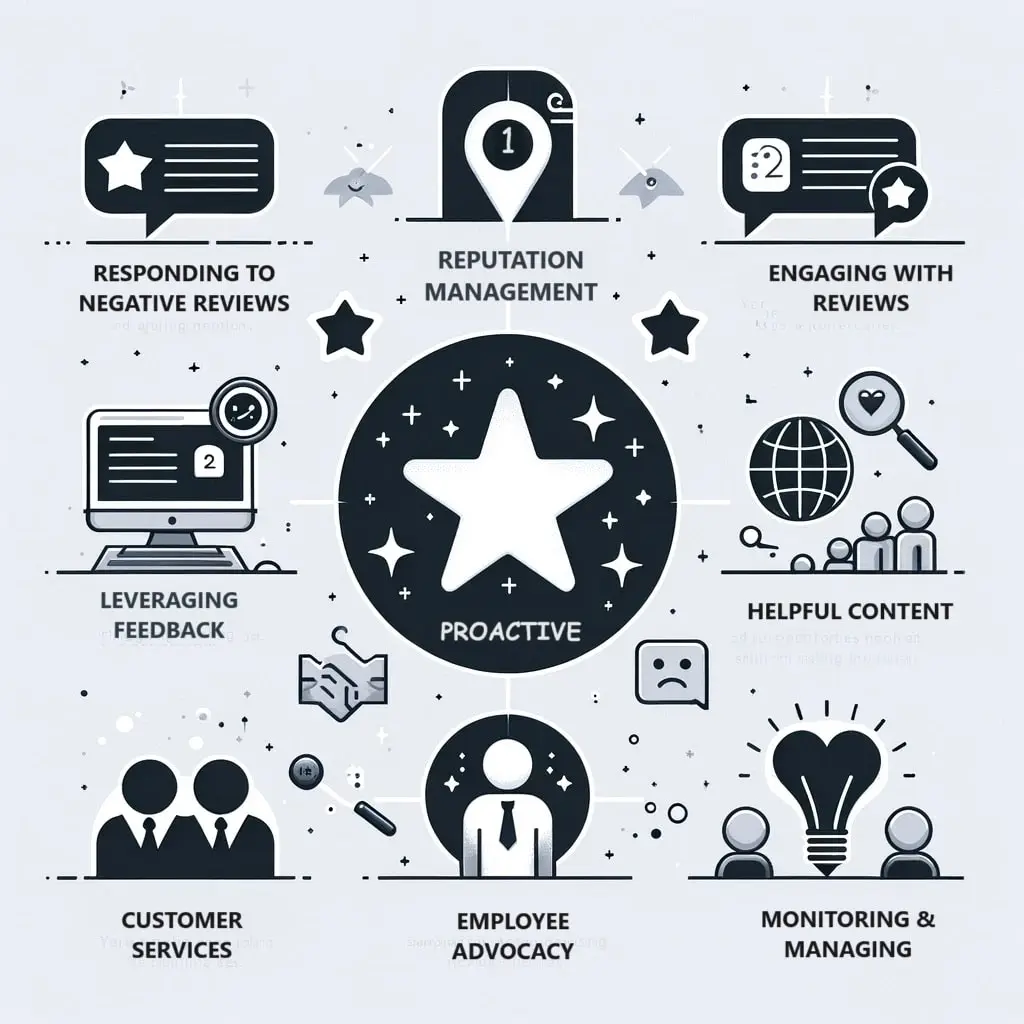
Here’s how different elements of reputation management contribute to local SEO:
3.4.1 Engaging with Reviews
Responding to reviews demonstrates to both potential customers and search engines that you value customer feedback. Regular engagement can also improve the visibility and perceived trustworthiness of your business. According to a recent study, customers expect a response to both positive and negative reviews within 48 hours.
3.4.2 Leveraging Feedback for Improvement
Utilizing customer feedback to enhance your products or services is a practice that can lead to more positive reviews and experiences, which in turn boosts your reputation and, by extension, your local SEO.
3.4.3 Responding to Negative Reviews
Negative reviews offer a unique opportunity to demonstrate your commitment to customer satisfaction. They allow you to showcase how your business responds to and resolves issues, which can be incredibly persuasive for potential customers reading reviews. Addressing negative feedback constructively and thoughtfully can turn unhappy customers into loyal advocates and positively influence other’s perceptions of your brand. Prompt, empathetic, and solution-oriented responses are key to effective reputation management. They can significantly contribute to improving your local SEO.
3.4.4 Content Creation and Sharing
Publishing valuable blogs, Q&As, and FAQs can significantly enhance your business’s reputation by demonstrating industry expertise and offering insights that engage your audience. This content can also attract valuable links and shares, bolstering your site’s authority and relevance for improved local SEO.
3.4.5 Employee Advocacy
When employees share positive experiences and act as brand ambassadors on social media, it significantly enhances the company’s reputation. A positive work culture, which fosters happy and engaged employees, is often reflected online. This not only attracts talent but also contributes to overall service quality and customer satisfaction. Encouraging employees to showcase their positive experiences can create a more authentic and relatable brand image.
3.4.6 Monitoring and Managing Your Online Presence
Keeping tabs on how your business is represented online and actively managing your presence across directories, review sites, and social platforms is essential for detecting issues promptly and resolving them. This proactive approach helps maintain a cohesive and positive image, which is vital for local SEO. Ensuring consistency and positivity in your online image directly influences customer perception and search engine rankings.
In essence, reputation management goes beyond simply collecting positive reviews. It involves an active, ongoing commitment to excellence and engagement that resonates with both your audience and search engines, leading to enhanced local search rankings.
3.5. Links
Backlinks, the digital endorsements from one website to another, are critical to both local and general SEO. They signal to search engines that others vouch for your content, contributing significantly to your site’s authority and credibility. For local SEO, backlinks from local sources such as community directories, local media websites, or partnerships with nearby businesses add a layer of local relevance, enhancing the ‘relevance’ aspect of your local search standing.
While local backlinks directly support your local search presence, high-quality backlinks from broader, non-local sources are equally valuable. They boost your site’s overall domain authority, which is a strong ranking signal for search engines. This, in turn, can enhance your visibility in local search results by increasing the ‘prominence’ factor, as a site with high authority is seen as more prominent and trustworthy.
It’s essential to focus on the quality of backlinks, regardless of their geographic origin. High-quality backlinks from respected, authoritative sites will propel your SEO efforts forward. Conversely, links from low-quality or spammy sites can detract from your credibility, potentially negatively impacting your rankings. Prioritizing high-quality backlinks, both local and non-local, will serve your SEO strategy well, reinforcing your relevance and prominence within the local search ecosystem.
3.6. Understanding Citations

Citations are references to your business found online. A decade ago, consumers primarily relied on phone books and hefty Yellow Pages volumes to discover and connect with local businesses. These physical directories provided essential details like business names, addresses, phone numbers, operating hours, and brief descriptions. However, with the rapid spread of the internet, this information has transitioned to the digital form. Today, hundreds of online business listing platforms exist, including digital versions of the Yellow Pages, where you can create and manage your business listings.
Citations primarily come in two forms:
Structured Citations: You’ll find these in business directories and listings such as Yelp, TripAdvisor, or Google My Business. These citations follow a standard format that typically includes your business’s N.A.P. information alongside other key details like business hours, categories, and services.
Unstructured Citations: These are mentions that occur in a less formal context, like a local news site article, blog mentions, forum discussions, or various social media mentions, which may include your business details in passing.
Both structured and unstructured citations help signal to search engines the legitimacy and locality of your business, enhancing your visibility in local search results.
3.6.2. Effective Citation Management
Maintaining your citations is a dynamic process that ensures your business information is accurate and up-to-date across the web. Here’s how you can manage them effectively:
Bulk Management of Structured Citations
For structured citations, there are platforms like Moz Local, Yext, or BrightLocal that offer bulk management services. These tools allow you to manage listings across multiple directories from a single dashboard, ensuring uniformity and saving time by distributing your N.A.P. information across their networks of sites with just a few clicks.
Individual Listings
If you’re not using a paid bulk service, you can still manually list your business on various platforms. This includes major directories like Google My Business, Bing Places for Business, and Yelp, as well as industry-specific and local directories. While this approach is more labor-intensive, it gives you direct control over each individual listing and can be a cost-effective way to ensure your business is represented accurately across the web.
Both approaches to citation management have their merits. Using a bulk management service can streamline the process and is particularly beneficial for businesses with multiple locations or those that frequently update their information. Conversely, individual listings allow for a more hands-on approach, which can be suitable for businesses with a single location or those just starting with Local SEO. Regardless of the method, the key is to maintain consistency and accuracy in your citations to support your local SEO efforts.
3.7. Behavior Signals

Behavior signals show how people engage with your website, revealing the success of your local SEO efforts. These signals are straightforward but influential, involving the frequency of clicks on your links (click-through rate), the duration of visits to your site (dwell time), and whether visitors keep coming back or leave quickly (bounce rate).
These metrics matter in local search because they reflect user satisfaction and relevance. For instance, a high CTR suggests that your listing is appealing and relevant to search queries. Longer dwell times can imply that visitors find your content valuable, potentially boosting your visibility in local search results. Conversely, a high bounce rate might signal that your site isn’t meeting users’ expectations, which could negatively affect your ranking.
Understanding these behavior signals can help fine-tune your local SEO strategy, ensuring that your website not only attracts local traffic but also engages and retains users effectively.
3.8. Personalization
As technology advances, search engine algorithms have evolved to become incredibly sophisticated. They now excel at understanding user search intent and delivering highly personalized search results. With user’s consent, they have access to their location, language, search history, devices, and more. They use this information to personalize results for the user.
For example, when you search for “barbers near me,” the results automatically include barbers located within your immediate vicinity, even without specifying your location. Similarly, consider a Spanish-speaking individual searching for a “personal injury lawyer in New York” in Spanish. The results they receive are tailored, likely showing lawyers who cater to Spanish-speaking clients, contrasting with results for the same query in English.
This level of personalization underscores the importance of optimizing for local SEO. It ensures businesses effectively reach their target demographic based on specific user preferences and search contexts.
Chapter 4: Local SEO Competitor Analysis
Throughout this guide, we have discussed the crucial aspects and factors that influence your local rankings. Still, without analyzing your highest-ranking competitors, you might miss important details that could cause problems and hurt your rankings.
In this chapter, we will guide you on how to do competitor analysis to get a view of the best practices your competitors are following to get an edge on them.
4.1. Identify Your Competitors
Whether you are starting your Local SEO strategy or revising it, knowing who your actual competitors are will pave the way to winning strategies. I say actual competitors because, with the proper research, you can keep the guessing business out and discover your real competitors.
Before you begin, it’s essential to have conducted basic keyword research. This foundational step is crucial for accurately identifying your competitors.
Steps to Discover Your Competitors
Set Up a Tracking Spreadsheet:
Step 1. Have your keyword research ready.
Step 2. Use Excel to create a sheet specifically for competitor tracking.
Step 3. Label columns as “Keyword,” “Standard Search,” “Near Me,” and “Local Area Search” (typically including your city name).
List Keywords and Variations:
Step 4. In the “Keyword” column, enter the primary search term from your keyword research.
Conduct Searches and Document Competitor Appearances:
Step 5. Conduct searches for the primary keyword, along with its variations. This includes searching for the keyword alone (for “Standard Search”), with “near me” added (for “Near Me”), and combined with your city or local area name (for “Local Area Search”).
Step 6. In the ‘Standard Search’ column, document the names of up to three companies typically featured in the Google Local Pack for that keyword.
Step 7. In the “Near Me” column, do the same for the keyword with “near me” added.
Step 8. In the “Local Area Search” column, record companies appearing for the keyword combined with your city or local area name.
Step 9. Repeat steps 6-8 for at least ten popular keywords you’ve identified.
Review and Analyze Data:
Step 10. Examine the data to determine which competitors frequently appear in local pack searches and identify the most frequently appearing competitors.
Identify Key Competitors:
Step 11. Dedicate a section of your spreadsheet to note these key competitors, including their total SERP appearances and any pertinent notes.
Step 12. Based on the analysis in Step 10, populate the “Key Competitors” section to clearly identify your primary competitors.
4.2. Competitor Analysis While Selecting Google Business Profile Categories

As highlighted in section 2.2.2, the selection of accurate primary and secondary categories for your Google Business Profile is critical to your local rankings. Often, this choice can seem daunting or may not receive the attention it deserves. By analyzing your competitors, you can cut through the guesswork and transform it into a concrete, actionable strategy.
This is where your top competitor tracking sheet comes in handy. Examine the Google Business Profiles of the top competitors identified in your tracking sheet to understand the categories they are using. This insight can guide you in refining your category selection to better compete in the local search.
The most straightforward way to see the primary and second categories of your competitors is by installing a Google Chrome extension called GMB Spy. It is fairly simple to use and will reveal both the primary and second categories of your competitors.
4.3. Analyzing Your Competitor’s Links
Backlinks, as we mentioned earlier in this guide, remain a ranking factor for both organic and local rankings. It’s also a factor that is highly competitive and requires a lot of effort. To simplify the process and to give you the groundwork to start, you can review your top competitor’s links profile by using the backlinks tool and simple tactics. This will inform you about what types of sites and content link your competitors.
One of the best and simplest ways to see your competitor’s links and citations is by searching your competitor by its name on a search engine. The search will reveal its listings spread over several pages. The hierarchy of those listings will reveal their value. You can then target those platforms for creating your own links.
You can utilize tools like Moz Link Explorer for a more detailed analysis. The free version offers a limited but feasible review of your competitor’s backlinks, while the paid version provides a more thorough review.
4.4. Analyzing Local SEO Factors of Your Competitors
With a solid grasp of who your competitors are, the categories they target, and their backlink strategies, the next step is to dissect their broader local SEO tactics. This encompasses a variety of factors that contribute to their local search visibility. By scrutinizing these elements, you can uncover more nuanced strategies propelling your competitors to the top of local search results.
To begin, focus on the following key areas:
- Online Reviews and Ratings: Assess the quantity, quality, and frequency of your competitors’ customer reviews. Pay close attention to their response strategy — do they reply promptly, personalize their messages, and address concerns? Analyzing these interactions can offer insights into how effectively they manage their online reputation, a critical component of local SEO.
- On-Page Local SEO Signals: Examine how your competitors optimize their website content for local search. This includes the use of location-based keywords, NAP (Name, Address, Phone Number) consistency, local landing pages, and other on-page elements.
- Local Citations: Look at where and how your competitors are listed online. Check directories, local business associations, and other citation sources to see how your competitors are represented and how current their listings are.
- Social Media Presence: Observe the activity and engagement on your competitors’ social media profiles. How are they leveraging social platforms to influence their local SEO?
- User Experience (UX) on Digital Assets: Visit your competitors’ websites and mobile apps, if available. Assess the user experience, including site speed, mobile-friendliness, and ease of navigation, which influence local search rankings.
Document your findings in your competitor tracking sheet as you analyze these factors. This will not only provide you with actionable insights but also help you benchmark your performance against theirs.
By thoroughly analyzing these Local SEO factors, you can identify gaps in your strategy and opportunities to outperform your competition in local search rankings.


